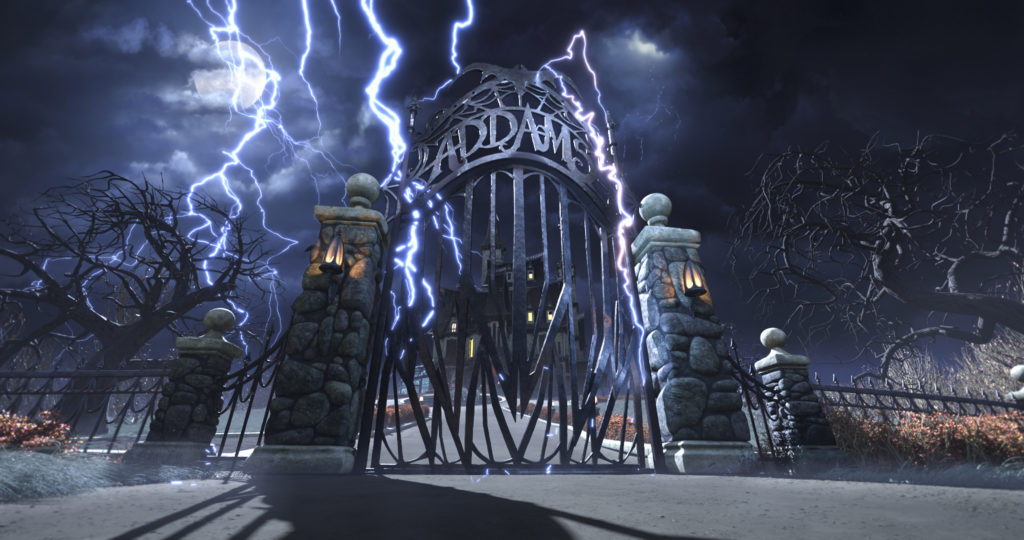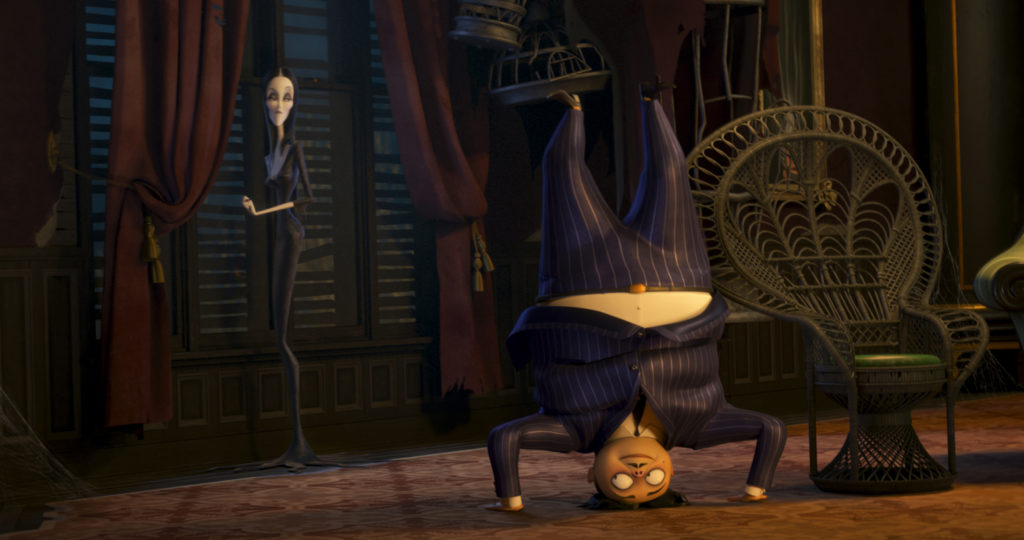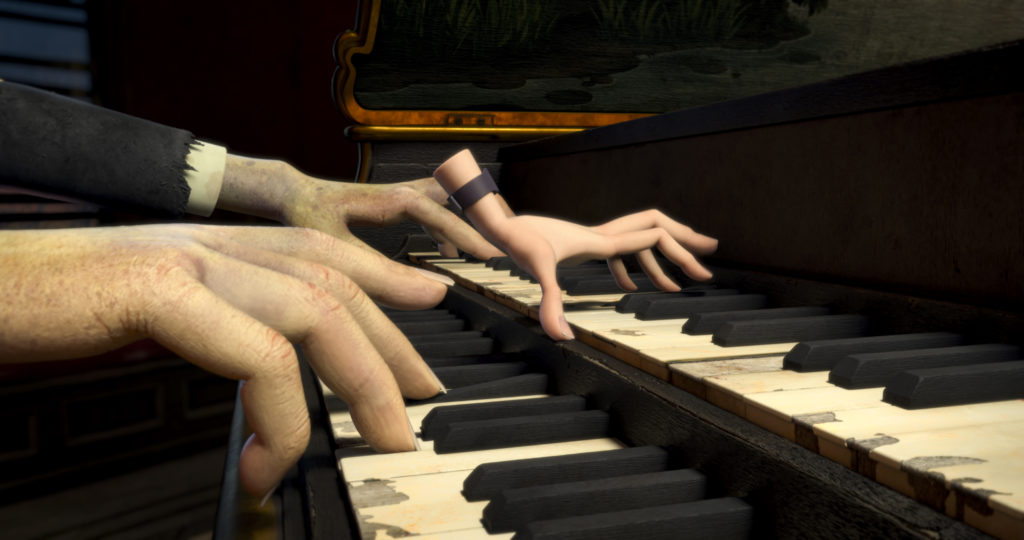Dum dum dum dum … snap snap. The iconic theme music from ABC’s 1960s horror-comedy television show The Addams Family has become a timeless and much-loved earworm, reprised in the many Addams Family films, sequels, and specials—even the hit Broadway musical. Inspired by the 1930s Charles Addams cartoons, the show followed a family of mysterious and often morbid characters whose names became part of the cultural lexicon. Paramount’s 1991 live-action adaptation helped keep the franchise in the public imagination, becoming the seventh-highest grossing film of that year.
The family is coming back to cinemas, this time in animated form, through United Artists’ The Addams Family, in theaters October 11. The stellar voice cast includes high-profile names like Charlize Theron, Oscar Isaac, Nick Kroll, and Allison Janney.
Co-directors Conrad Vernon (Shrek 2, Monsters vs. Aliens, Madagascar 3: Europe’s Most Wanted) and Greg Tiernan (Sausage Party) spoke to Boxoffice Pro about making the Addamses an immigrant family, flipping Thing, the disembodied hand, from righty to lefty, and directing a family-friendly film after their previous co-directorial effort was rated a hard R.

Was it an extreme jolt going from Sausage Party to The Addams Family?
Vernon: Well, we’d done [family-friendly] things before Sausage Party. Greg did a preschool TV show [Thomas & Friends] while I’d worked for DreamWorks for 20 years. But MGM did love that movie! They were sausage admirers.
Tiernan: But there are a few jokes for the adults in this one. The Addamses, going back to the original cartoons in the New Yorker, it’s all adult-based material. Nick Kroll, playing Uncle Fester, just came up with all sorts of stuff that wasn’t in the script. When Wednesday at the breakfast table says, “Uncle Fester can go wherever he wants,” he came up with, “No, I can’t go into a school.” But we had to take that one out! There’s another line of Nick’s that we had to take out where he said, “We should jump out of those bushes and expose ourselves … emotionally.” Those jokes were maybe just a smidge over the line of family-friendly.
Vernon: We had Gomez and Morticia in the back seat of a car, speaking lovingly to each other in French. They slowly sank down in the back seat together, like they were going to make out. We played that for a test audience, and there was a 6- or 7-year-old kid who shot his hand up afterward and said, “When Gomez and Morticia were in the back seat, that was very, very inappropriate!” We took it out because this 7-year-old told us to.
What was the most challenging aspect of making this film?
Vernon: Walking this tightrope between making a movie that audiences who grew up loving The Addams Family would feel represented them properly, and bringing in a new generation of children who maybe don’t know The Addams Family—making sure they’re entertained as well. We had to walk this fine line between fans and a brand-new audience.
Tiernan: Many times we’d come up with a gag or a piece of dialogue and we’d say, “Oh, that’s perfect for Morticia.” But then we’d have to remind ourselves that there’s a lot of the younger audience who have no idea who Morticia is or her history. Not over-explaining the Addamses, but also not ambushing the audience with “Just pick it up as you go along.”
So did you include any Easter eggs that refer to the original material?
Vernon: There’s a ton of them in there. We had a large book that had all the old New Yorker cartoons in it. We went through it, and not only did we find a bunch of lines we liked in there, but we also took a lot of Charles Addams’s old character designs and turned them into extended family members. There’s also a character that’s an Easter egg; he appears four or five times, but you have to look for him. He’s right out of the old Charles Addams cartoons, because he used to hide this one character in the background of his cartoons. See if you can spot him! We also did some fun things with Snoop Dogg, who voices Cousin Itt. You can watch the movie two or three times and get something different out of it each time.
How much did you try to emulate the ’30s cartoons versus the ’60s television show versus the two ’90s movies versus doing your own thing?
Tiernan: Very much. We went back to the well of Charles Addams. One of the other challenges we had was, especially for such an iconic family: How to present something different and put our own stamp on it. Both Conrad and I grew up watching the TV show and also the movies. Personally, I loved them. Those actors really brought something to those characters that went above and beyond, so we had to try and do the same thing. But we needed a firm foundation to be able to do that. We really went back to the Charles Addams originals for the character designs. We had a fantastic character designer, Craig Kellman, who’s worked with Conrad for many years and worked with us on Sausage Party. Between him and our producer Alex Schwartz, we really did our best to take what Charles Addams had given the world and use that as our foundation to build on.

How did you go about putting your own stamp on it?
Vernon: We tried to do something with the story that had not been done with any of the other iterations. [The villain is the new character Margaux Needler, a reality TV host.] We also have a scene at the beginning of the movie with Morticia and Gomez before they’ve had children, before they meet Lurch, before they find their house. It’s the origin of who they are, before they actually turn into the Addams Family that we know. Plus, we’ve turned them into an immigrant family. We thought the idea of an immigrant family migrating to this country was particularly poignant. We weren’t making any sort of political statement, although now it is a topic on people’s minds. It was a story about this family that people could relate to, and we could say something important.
Tiernan: When Craig [Kellman] was designing Thing [a disembodied forearm who’d always previously been right-handed], you’d think a hand is a hand is a hand. But Craig’s design was a left hand, probably because he’s left-handed! Thing was never a disembodied hand in the original Charles Addams cartoons; that was made for the TV show. Once we realized that, we figured we’re not breaking any of Charles Addams’s designs.

How do the two of you co-direct?
Tiernan: It’s completely joint. It was the exact same thing on Sausage Party. Conrad and I met way back in the early ’90s on Cool World [a 1992 live-action/animated crossover in the style of Who Framed Roger Rabbit? and Space Jam]. We weren’t directing that; I was animating and Conrad was doing effects. On Sausage Party and, it’s a little bit twee to say, but we sort of think with one mind when we’re working. I’m proud to say that we never had a cross word between us. If Conrad feels a bit more strongly on a story point or a design issue than I do, I step back. And he does exactly the same for me. We never make decisions without one another. I don’t know how it works, but it does.
What’s an example of a time when the two of you resolved a disagreement?
Vernon: Just this morning! Yesterday I went to the D.I. [digital intermediate] house, where we look at the final shots, to make sure that the color and everything is correct. There was a point near the end of the movie where the camera was shaking, but when I was watching, the camera was shaking so much that I couldn’t focus on anything. So I texted Greg this morning and said we’re going to have to bring that camera shake down by at least 50 percent. And he said, “Oh, OK.” We hadn’t had any camera shakes at first, so I put some in, but then it was too much. That’s a perfect example of how we work together.
The Addams Family theme song is classic. How did you incorporate that?
Tiernan: That theme has been so iconic for so many years that it would have been a travesty to leave it out. We have an absolutely amazing score for the movie, by Mychael and Jeff Danna. They incorporated the theme into the score in several places. I won’t tell you exactly where, because some of them are Easter eggs.
Is this the type of movie to be enjoyed on the big screen at a cinema?
Vernon: The design and work that our production team put into the detail and the background, this is like no other film that’s out there right now. Every single detail, down to end tables and lamps, have been designed by our production team and just beautifully rendered on the screen. I don’t usually go to 3-D movies, but the 3-D shots on this movie in particular really do make you feel like you’re in the house with them. Look at the backgrounds, the carpet, the drapery, the old television sets from the 1950s, all the weird little toys that we designed and scattered throughout the house. Wednesday has an electric chair in her bedroom. Pugsley has a stretching rack for a bed. You’re not going to catch all that if you were watching it on your phone. There’s an immensity and a cinematic quality we tried to instill.
Tiernan: I’ve always believed that theatergoing is an event, from the golden age of cinema right up to today. Whether you go in there as a first date or because your favorite star’s new movie is out. There’s nothing wrong with sitting down in your own living room and streaming or watching whatever. But to actually go out to a movie, especially if you’re there with friends or family members, that turns it into something a little bit more special. By all means, watch it over and over again at home! But watch it on the big screen first.


Share this post